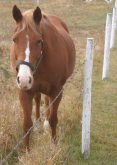For the second winter in a row pharmaceutical companies are hearing lots of complaints about scratching cattle and hair loss.
This means that producers and veterinarians may need to change how they routinely treat for lice.
First, a positive diagnosis is important. We may handle biting lice, sucking lice and chorioptic mange differently and many times the scratching and hair loss may have other causes.
The lice article written by Dr. John Campbell and published recently in The Western Producer can be a valuable resource. In it, Campbell describes the life cycle, egg production and where on the animal to look for lice.
Read Also

Beef check-off collection system aligns across the country
A single and aligned check-off collection system based on where producers live makes the system equal said Chad Ross, Saskatchewan Cattle Association chair.
I would always look on the periphery of the scratching, and lice will be higher in the areas where the cattle can’t get at to lick. Often, a magnifying glass may be necessary to find them, or an area clipped and scraped or parted with a comb. Once we have a diagnosis, a plan can be made.
Some producers may have become complacent over the years because the ivermectin type pour-on products did a good job. With many years of use, it is looking like the endectocides are lacking some efficacy and potentially resistance may be developing. With biting lice feeding on the surface and always moving, we can’t expect a systemic product to totally control them but now we are also identifying large numbers of sucking lice.
Lice are the most common and persistent parasite in wintered cattle in Western Canada. There is one species of biting lice (they cause severe irritation and scratching) and three of sucking lice (they cause anaemia and weight loss) on Canadian cattle.
In one older two-year study of calves entering southern Alberta feedlots, 57 to 95 percent of calves were lousy to varying degrees.
This indicates a very high infestation rate on some of our cow-calf herds. I know this to be true from examinations and autopsies we do, especially on small herds, which often do not treat. We often identify lice when doing caesarean sections or hooking up calves to intravenous fluids, and once the hair is clipped, lice are obvious. These findings are being reported more and more by veterinarians.
Herds will have carrier animals, ones that have an abnormally high population of lice. These animals may be immunosuppressed or have a concurrent disease. Cattle in poor nutritional shape will have lowered immune responses and allow lice to build up quickly. This is also true if cattle become extremely loaded with internal worms.
With today’s confinement, larger herds can exacerbate lice transmission. Young calves are especially vulnerable because a lot of their energy is being put into growth. It is extremely important to have the cows lice-free at the start of the calving season so the calves don’t become infested. The close proximity to each other and sucking the udder allow for easy transmission of lice between dam and calf. I have seen severe lice build-ups in calves as young as two weeks.
A lice control strategy must treat at the right time, which is the late fall and early winter. It is getting colder and as cattle’s winter coats become longer, it is more difficult for the animals to groom the lice out by licking. I believe some herds are treated when convenient, which may be too early. Severely infected carrier animals may need to be culled from the herd to avoid transmission. With good nutrition and keeping internal parasite numbers low, the immune system is better able to cope with lice.
Until new products come out the macrocyclic lactones (ivermectin-type pour-on products) in the early winter, which have a residual follow up by the pyrethroid family of pour-ons in January or February, may be the best one-two combination.
Many producers seeing reoccurrence are switching to the category 3 pyrethroids such as Boss, Saber or Cylence because they have indications for both types of lice. These are also small-dose, pour-on products and because they are a different class of chemical, they seem to be effective and have short withdrawal times. These are not long-term residual products, so it is recommended to retreat cattle in two to three weeks if necessary.
Changing treatments and alternating between the endectocides and pyrethroids may be a way to get greater effectiveness. Also, if you applied the endectocides in the cold winter and got icing up of the product, that greatly reduces its effectiveness. Endectocides have a freezing temperature not much below -10 C. It is advisable to apply any of the pour-on products on warmer days above -10 C.
In the future, researchers will discover ways to diagnose quickly and develop targeted treatment of select groups of cattle. We all know once spring comes and temperatures go up, lice go away.
Hair coats become shorter so natural grooming also removes more lice.
It may be necessary to have a good discussion with your veterinarian on better ways to strategically treat lice on your farm.

















